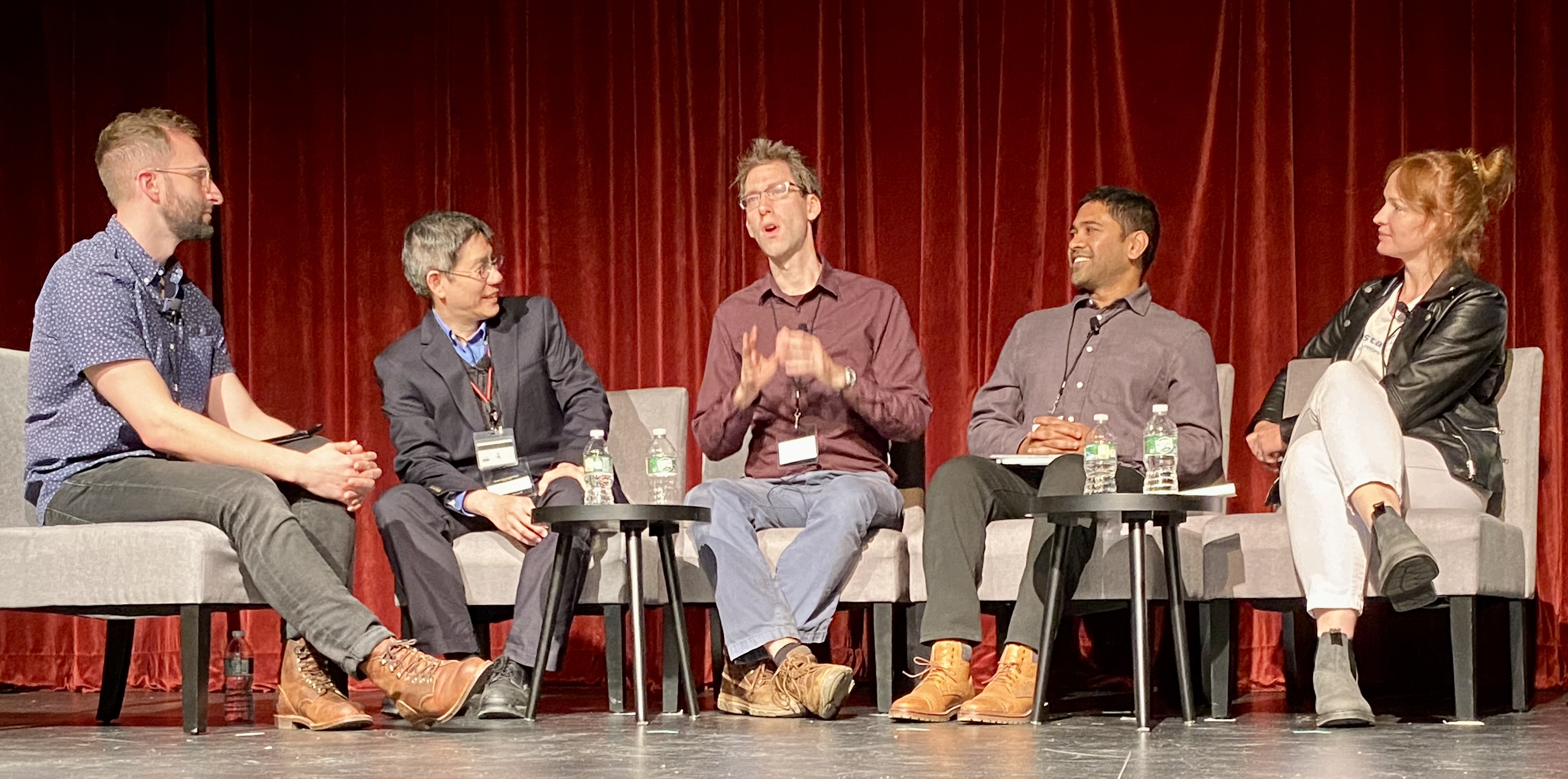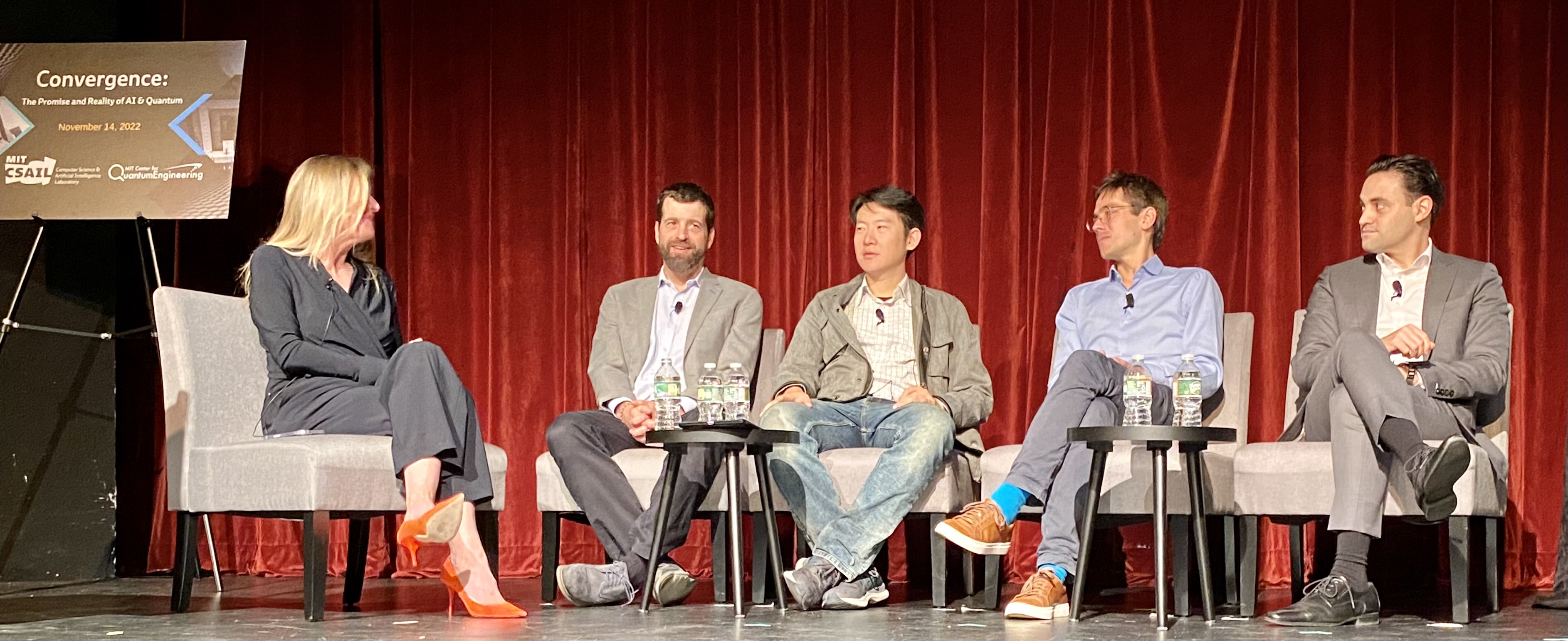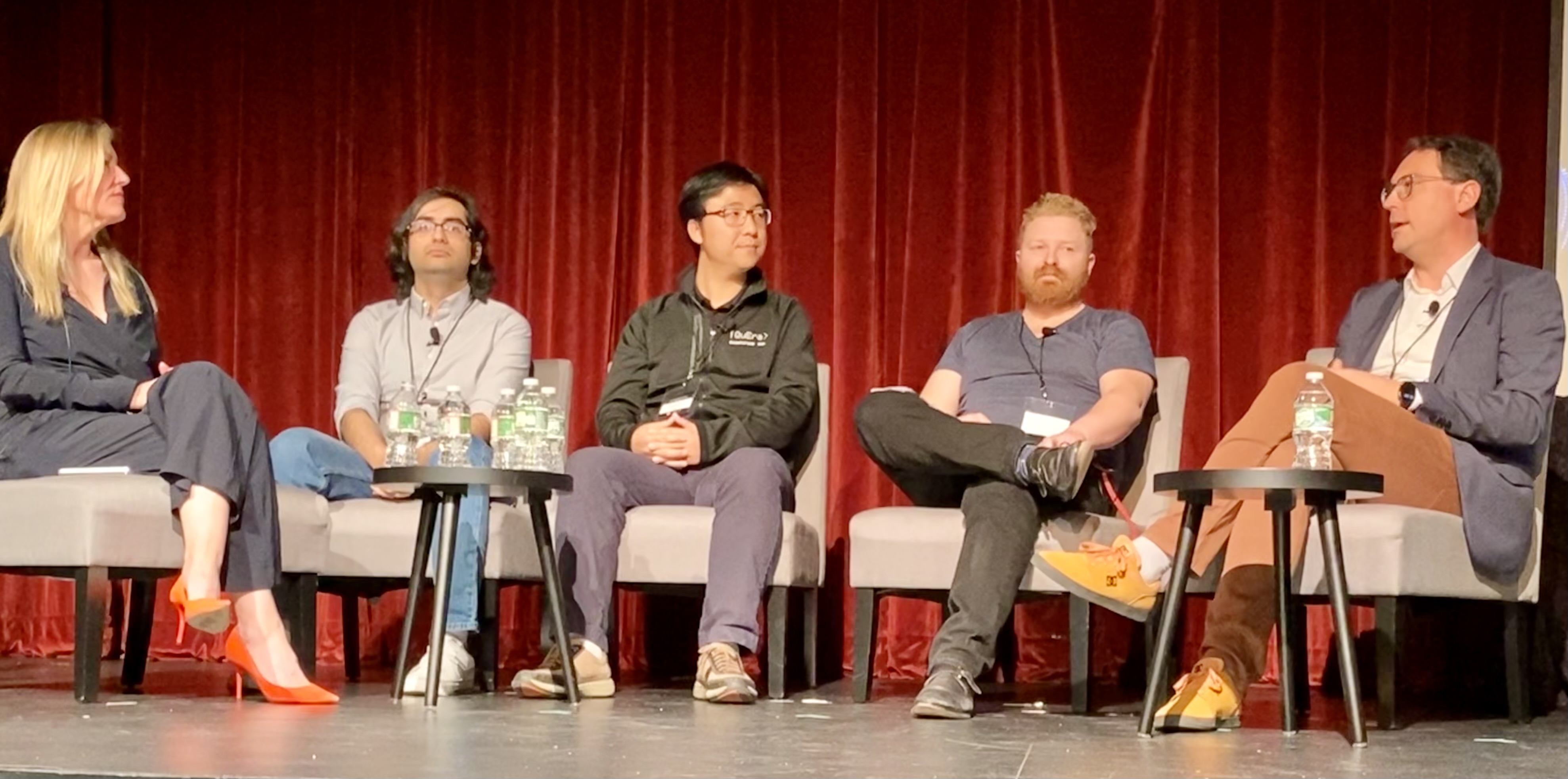WRITTEN BY: Audrey Woods
INTRODUCTION
In her opening statement for Convergence: The Promise and Reality of AI & Quantum, CSAIL Alliances Managing Director Lori Glover called AI and quantum computing “two of the most talked about, hyped, and invested-in technologies of today.” Indeed, news of these exploding fields of computer science has been accelerating and with it, public curiosity and market interest. AI automation has inspired an ongoing international dialogue, and an array of quantum startups are beginning to attract industry attention. As CSAIL Director Professor Daniela Rus said, the coming “technical explosion is going to make the technical change of the last 50 years or so since the introduction of the personal computer look insignificant.”
On November 14th, experts from academia and industry gathered at MIT to discuss the state of AI and quantum technologies, exploring what is real, what is hype, and what is coming next.
PROFESSOR WILLIAM OLIVER: THE STATE OF QUANTUM COMPUTING, KEYNOTE
Director of the MIT Center for Quantum Engineering Professor William Oliver gave the keynote speech on quantum computing, offering an up-to-date snapshot of where the field currently stands. He began by acknowledging the hype, saying “the reason there’s hype is because there is substantial promise to this technology.” Professor Oliver said we’re entering a “second quantum revolution,” or what he calls Quantum 2.0, which takes the understanding of quantum mechanics that was developed in the last century and allows us to not only use such knowledge to comprehend the world but apply it functionally in the form of quantum computers. Careful to set realistic expectations, Professor Oliver compared his field to aviation, explaining that current quantum technology is at the stage of the Wright Flyer, where the elements are coming together with tangible results. “Quantum is real and has a lot of promise,” he said, “but it’s going to take time and it’s going to take science and engineering.”
For audience members unfamiliar with quantum computing technology, Professor Oliver walked through the basics of how quantum computers work. He explained that, while classical computers use bits which can be in a state of either one or zero, quantum computers use qubits, which can hold a superposition state of both one and zero simultaneously. “You can think of a qubit as planet Earth,” he said, “where the North Pole is state zero and the South Pole is state one… but we can be anywhere else on the surface of the planet Earth, and when you’re anywhere other than the North or South Pole you’re in a quantum superposition.” Therefore, until the act of measuring “snaps” the qubit into one position or another, a quantum computer can carry many aspects simultaneously in one superposition state, leading to exponentially larger computing power. To demonstrate this, Professor Oliver described how a 30-qubit computer is roughly equivalent to a modern laptop, but with only ten times the qubits, a 300-qubit computer would be more powerful than a theoretical classical computer that utilized every single atom in the known universe as a memory element. Such is the power of exponential growth.
PROFESSOR DANIELA RUS: THE STATE OF ARTIFICIAL INTELLIGENCE, KEYNOTE
Speaking about the state of AI, CSAIL Director Professor Daniela Rus said, “we are surrounded by a world of opportunities.” She began by asking the audience to imagine a future where routine tasks like trash collection and grocery shopping are automated and optimized for maximum effectiveness. AI, Professor Rus explained, can create a better future by “allowing human workers to focus on bigger picture tasks like critical thinking and strategy while machines take on the routine tasks.” Beyond that, the combined efforts of humans and machines in certain situations, like cancer diagnostics, can minimize error and catch what the other might miss. In this way robotics, AI, and ML have the potential to bring about a positive and productive vision for humanity.
As with any computer science field, there are challenges to address, such as data availability, data quality, computation cost, environmental concerns, interpretation, and model robustness. For instance, Professor Rus said that “training a medium-sized language model releases 626,000 pounds of carbon dioxide into the atmosphere,” which is equivalent to the lifetime emissions of five cars. She also described the problem of explainability, or the fact that it’s difficult to understand what’s happening in these systems and therefore be ready to anticipate when it might fail. However, MIT researchers are hard at work coming up with solutions to these issues and building AI systems that are closer to being certifiable. One such idea that Professor Rus highlighted is a new kind of neural network called a “liquid time constant network,” or a “liquid network.” In a series of videos, she showed how these improved models don’t degrade as much as other systems, are provably causal—which means they can relate cause and effect together—and perform better in changing environments, such as different seasons. This new kind of model shows tremendous promise in safety-critical situations like autonomy, where the AI must be able to adapt to various situations and noise levels while remaining reliable and safe.
Emphasizing other key projects advancing the state of today’s AI solutions, Professor Rus touched upon Professor Aleksander Madry’s research on reliable and robust AI, Professor Tim Kraska’s efforts to build infrastructure that will allow non-experts to use AI, Professor Regina Barzilay’s work translating and deciphering lost languages, and Professor Bonnie Berger’s efforts using AI to model viruses in the creation of new vaccines. Professor Rus ended by expressing her excitement for the potential of quantum computing, which “would make a huge difference in how we train [models] and how we do inference in machine learning.” She said that “AI holds tremendous potential [but] these solutions rely on huge amounts of computation and huge amounts of data.” Therefore, there are many ways the training of AI could benefit from quantum computing, especially in reducing the environmental footprint, which alone would be a “huge win.”
In their Q&A session, Professor Rus and Professor Oliver agreed that it is an excellent time for the convergence of their two fields.
PANEL 1: WHERE ARE WE WITH QUANTUM AND AI (REALLY!) AND WHERE WE ARE GOING
The first panel of the day, moderated by MIT Research Scientist in the Engineering Quantum Systems Group Jeffrey Grover, brought together experts on quantum computing and artificial intelligence to engage in a discussion about where the technologies currently stand and what the future will bring in their respective fields. On the quantum side was MIT Professor Ike Chuang—known for being the first to realize Shor’s algorithm—and MIT Professor Aram Harrow. Representing AI was MIT Principal Research Scientist Kalyan Veeramachaneni and Co-Founder and COO of Hosta a. i. Henriette Fleischmann speaking about her startup that uses AI for property assessment.

The panel agreed that AI is currently solving more real-world problems than quantum, with Fleischmann’s startup as a key example. As Dr. Veeramachaneni explained, AI models have already proved useful, “specifically in domains like finance, online retail, or your streaming services.” However, the panel discussed some of the challenges the AI field faces, namely developing ways to evaluate model success in complex situations, getting enough good-quality data—including edge cases—to train a model without prohibitive labeling expenses, and the environmental impact increasingly large and complex AI models will have. Fleischmann also touched upon the barrier of industry awareness and the importance of “educating everyone about what AI actually does.”
On the quantum side, Professor Harrow and Professor Chuang expressed the excitement of a field in its early stages, just beginning to transition from theory into empirical reality. Using the increasing interest in quantum classes at MIT as evidence, Professor Chuang demonstrated how the area of research is growing and the consensus around quantum’s potential is reaching a tipping point. When asked how best to craft quantum algorithms, Professor Harrow said that scientists should be approaching the problem from both the theory side and the empirical side, taking elements of what works in theory and applying them to real data to constructively iterate more successful algorithms. Ultimately, both professors established that the biggest challenge in quantum computing at this time is figuring out when and how best to use quantum computers. “What’s missing is we don’t yet know the right problem to apply quantum to,” said Professor Chuang, with Professor Harrow adding that he is excited to see “how quantum computers can work with the very successful classical computers [we currently have].”
PANEL 2: INDUSTRY USE CASES
The second panel of the day showcased a series of real-world applications of both AI and quantum solutions. The discussion started with MIT Professor Samuel Madden speaking about a startup he co-founded with MIT Professor Hari Balakrishnan called Cambridge Mobile Telematics (CMT). Using machine learning and AI, CMT aims to make the roads safer by creating products that utilize phone and car sensors to improve driving and decrease accidents. Representing Zapata Computing, CTO and co-founder Yudong Cao spoke about his team’s approach to quantum computing software, specifically the idea of deep learning paradigms like generative modeling being the “shortest path to a quantum advantage.” He used the Zapata-BMW-MIT collaboration optimizing BMW’s car manufacturing process to demonstrate quantum’s promise with “very complex optimization problems.” On the hardware side, co-founder and COO of Atlantic Quantum Tim Menke discussed building “fault-tolerant, scalable quantum hardware.” He talked about running quantum-style algorithms on classical computers with promising results and how Atlantic Quantum aims to overcome the current limitations of quantum hardware to create quantum systems at scale. Bringing the perspective of the finance industry to the conversation, Michael Rappaport, head of Emerging Technology at HSBC, discussed the strategy of investing in quantum and AI technologies. To him, AI and quantum show exciting potential in optimization, fraud detection, and other issues specifically relevant to banking, and while “this is a technology that is not necessarily ready today,” HSBC is continuing to “do things [to] be ready when the time comes down the line.”

There were a few noteworthy consensuses among the panelists, namely the challenge of, as Professor Madden puts it, “making sure you’re really building a product that everybody wants.” Dr. Cao agreed, describing how the process of tweaking something for a customer, something he once thought of as “thankless engineering,” actually “gave rise to some of the most interesting science questions.” The panel moderator, Executive Director of the MIT Center for Collective Intelligence and Senior Director for MIT Horizon Kathleen Kennedy added how her own experience has shown that engaging companies to share their “real world challenges and input [can] help accelerate what we’re doing.” She highlighted how CSAIL Alliances provides this bridge between industry and academia.
Beyond that, there was also a repeated theme of, as Dr. Menke puts it, “figuring out is this even a problem that could be potentially run on a quantum computer.” For instance, one motif of the conversation was that quantum computers don’t operate well with lots of data and need either small representative subsets of data or the assistance of an AI model to provide distilled data that the quantum algorithm can use. Therefore, the panelists agreed that it’s worth thinking deeply about where quantum can be applied and how AI can be leveraged to improve future use case scenarios. Dr. Menke finished by saying that “Boston is a fantastic ecosystem for this type of work” and how important this growing network of researchers, industry affiliates, and investors will be going forward.
Beyond that, there was also a repeated theme of, as Dr. Menke puts it, “figuring out is this even a problem that could be potentially run on a quantum computer.” For instance, one motif of the conversation was that quantum computers don’t operate well with lots of data and need either small representative subsets of data or the assistance of an AI model to provide distilled data that the quantum algorithm can use. Therefore, the panelists agreed that it’s worth thinking deeply about where quantum can be applied and how AI can be leveraged to improve future use case scenarios. Dr. Menke finished by saying that “Boston is a fantastic ecosystem for this type of work” and how important this growing network of researchers, industry affiliates, and investors will be going forward.
ON THE HORIZON: RESEARCH HIGHLIGHTS FROM PROFESSOR KEVIN O’BRIEN, PROFESSOR VLADAN VULETIĆ, AND PROFESSOR MANOLIS KELLIS
The first speaker to discuss their research was Professor Kevin O’Brien from MIT EECS speaking about his group’s work developing quantum-limited amplifiers. He started by introducing superconducting Josephson traveling wave parametric amplifiers (JTWPA), which have high gain, broad bandwidth, and a noise performance within a factor of 2 of the quantum limit. His team has since improved upon this research by developing a “new fabrication process that mitigates dissipation [within] the amplifiers,” reaching a near lossless performance. Professor O’Brien also explored how “squeezing the quantum vacuum enables noise performance better than the standard quantum limit,” which has applications in particle physics. Ultimately, Professor O’Brien’s message was that “quantum technologies have real-world impact both in quantum computing as well as in other fields,” and that, on the journey to develop quantum computers, many other areas of research will benefit from the resulting technology.
Next to the podium was Professor Vladan Vuletić from the MIT physics department to talk about quantum computing with neutral atoms. He described how his group is creating long-lived qubits by trapping rubidium atoms in two-dimensional planes using laser beams such that they can be controlled, moved around, and rotated. With a series of images taken from their research, Professor Vuletić showed how the atoms can “create an almost perfect pattern 99% of the time.” He went on to explain how his research is addressing quantum error correction, which is famously difficult because it’s impossible to look at the state of the qubit without destroying the quantum state. However, his group’s research offers one possible solution to quantum error correction using entanglement and toric code. He hopes we’ll have quantum computing hardware with error correction “in the next two years.”
The session ended with a talk by Professor Manolis Kellis of CSAIL about “the role AI can play in understanding human health, understanding medicine, and enabling the future of both precision medicine and personalized medicine.” As Professor Kellis explained, “it all starts with genetics” because understanding the genetics of a disease is the first step in combating it. However, this can be difficult in disorders like obesity, Alzheimer’s, and cardiac disease where there are potentially thousands of genes scattered across the genome that have a role in disease progression. This challenge presents an opportunity for AI solutions, which can allow researchers to understand how “thousands of variants converge in a small number of pathways,” thus helping predict or even manipulate disease progression. He also discussed his group’s work creating AI models for understanding clinical records, using AI to map the various pathways altered by Alzheimer’s, and applying AI in designing new therapeutics, drugs, and medical chemistry. He ended by saying it is an “extremely important time for us to bring AI to medicine.”
FIRESIDE CHAT WITH PROFESSOR WILLIAM OLIVER AND PROFESSOR PETER SHOR

Sitting down with what moderator Kathleen Kennedy called “quantum royalty,” she guided a lively conversation between Professor Peter Shor, inventor of Shor’s Algorithm and winner of the 2022 Breakthrough Prize in Fundamental Physics award, Professor William Oliver, Director of the MIT Center for Quantum Engineering, and the audience, both in-person and online. The discussion began with a question about what’s most exciting about quantum at the moment, which Professor Shor answered, “the hardware is now getting big enough that it’s possible to think about doing things with it.” Professor Oliver agreed, adding that “it’s the very beginning [of the quantum computing field] and it’s really exciting.” Many of the audience questions had to do with the challenges quantum computing faces, such as the problem of data. As Professor Shor explained, a quantum computer can only store a tiny amount of data at once, so it will take some “really clever” programming to figure out how to use quantum computers for AI training. Professor Oliver brought up one potential solution of using quantum computers in tandem with classical computers, although he admitted that such hybrid technology is still in the theory stage. A second problem in quantum computing, which several speakers and panelists had touched upon during the day, is the issue of putting quantum computers into practice. As Professor Shor said, “if you look at the history of classical computers, a lot of computer algorithms were not discovered by theory… they were discovered by actually coding them up and seeing that they did work.” Professor Oliver added, “when you do things, things get done,” expressing the need for real-world problems on which to test the quantum theory now being developed.
Professor Oliver and Professor Shor also brought up how difficult it is to conceptualize quantum algorithms. Professor Shor explained that making algorithms where the right paths interfere constructively and the wrong paths interfere destructively—a simplified depiction of how quantum computers come to a correct answer—is “something that our intuition is really, really bad at.” On the topic of educating future quantum engineers, Professor Oliver said “we need to develop abstractions” to help people understand quantum, which might even involve creating games that train children to think about quantum in more intuitive ways. Summing up the conference, Professor Oliver said that he’s excited to see “how quantum can both leverage AI and machine learning and also contribute back to the training of quantum AI and quantum machine learning,” a synthesis of fields that is aided by events like Convergence. Professor Shor ended by saying, “it’s been nearly 30 years since I discovered [Shor’s] algorithm and it’s been a lot of fun seeing what’s happened, and I think it’s going to be a lot of fun seeing what happens in the future.”
PANEL 3: CONSIDERATIONS IN SETTING A QUANTUM AI STRATEGY
The final panel of the day featured four industry representatives discussing their strategy for identifying and incorporating quantum and AI technologies. First to speak was Emerging Technologies Manager for the BMW Group Marcin Ziolkowski, who explored how BMW is investing in and applying these emerging technologies. Dr. Ziolkowski went into more detail about the MIT-Zapata-BMW collaboration, explaining how complex the problem of factory optimization becomes with large production centers and that even slight improvement with a quantum solution has significant implications. Acknowledging that quantum is a “long-term investment,” Dr. Ziolkowski said companies such as BMW were convinced that they should invest in quantum computing after the buzz of Shor’s algorithm, especially as Europe prioritizes “digital sovereignty.”
Head of Artificial Intelligence Douglas Hamilton spoke about how Nasdaq is bringing AI solutions to market and how quantum might be able to help with that. Hamilton began by talking about the unique capabilities AI provides and industry excitement around the idea of “digital nudging,” or using technology to shift the needle even a few percentage points for marginal but potentially momentous gains. To illustrate the value of digital nudging, Hamilton said, “there’s a huge amount of pain and death and destruction associated with financial crises, so avoiding them, even if it’s only reducing their likelihood by a percentage point or two or their depth by a percentage point or two, isn’t just good for your wallet, it’s actually quite good for the world.” Therefore, Hamilton is excited for niche quantum advantage combined with AI, which he hopes is only 2-5 years away. Speaking in a similar vein was Applied Research Lead at JPMorgan Chase & Co. Shouvanik Chakrabarti. Dr. Chakrabarti’s team focuses on quantum optimization and developing quantum applications that are both faster and fault tolerant. Walking through the challenge of finding out when and how quantum computers are best applied, Dr. Chakrabarti said he’s not only attempting “to speed up the things that people already do” but also finding problems—like predicting market crashes—that aren’t being addressed today because they’re too difficult and seeing if they can be solved with quantum.

Finally, Senior Research Scientist at QuEra Computing Shengtao Wang spoke about how his startup is bringing quantum technology to the market. Based in Boston, this 3-year-old company has developed a 256-qubit neutral atom quantum computer. Being on the ground in the development of quantum computing, Dr. Wang discussed the main challenges a quantum startup faces, namely developing useful algorithms and co-designing these algorithms to work with the hardware that’s currently available. Even though he believes quantum could “potentially revolutionize the world,” Dr. Wang said that QuEra is focused on “how do we provide value and usefulness today.” With that in mind, he touched upon how QuEra technology is currently being applied to physics research and extrapolated that the first round of users will likely be academics studying the subatomic world. Like Professor Oliver, Dr. Wang believes, “we just need to provide the hardware large enough and robust enough so that people can start playing around with it and find out what they can use [quantum computers] for.”
FINAL THOUGHTS & MOVING FORWARD
The program ended with closing remarks from Professor Oliver and moderator Kathleen Kennedy. Professor Oliver said, “this is the first page of a long story between AI, machine learning, and quantum technologies,” a story he invited industry participants to be a part of. Kathleen Kennedy added how she’s “really encouraged by what I see with the collaboration between academia and industry” and thinks we’ve reached a stage where “people are starting to be able to roll up their sleeves and do things.” She aims—as does the Alliances team—to help everyone understand the basics of quantum and AI so that these technologies can come to realize their full and exciting potential. If you want to continue the conversation with CSAIL, the MIT Center for Quantum Engineering, and attendees, join our Convergence LinkedIn group or contact us at CSAIL Alliances for more information.





